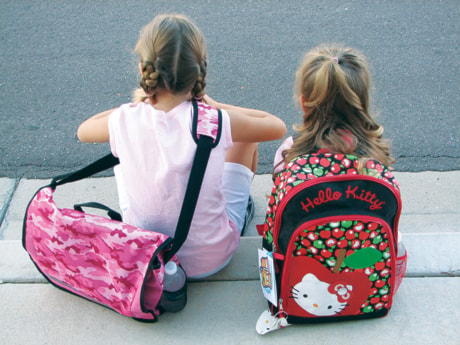TORONTO — Some students may favour fashion over function when it comes to the bag they’ll use to tote their books and supplies as they head back to class.
But the president of the Ontario Kinesiology Association says there’s more to selecting the right backpack than looking stylish — particularly if students want to avoid potential injuries or chronic conditions that may arise from wearing overloaded bags.
Mike Dickin said the ideal backpack has two wide, padded straps worn over both shoulders.
“Dual straps load the weight evenly against the child’s back and don’t cause them to have to move or compensate by moving in certain directions or leaning in certain directions to compensate for the weight,” he said from Shelburne, Ont.
And while some kids may not find it cool, Dickin said a good backpack also has a waist strap which helps to distribute some of the weight of the pack onto the hips rather than the shoulders.
Dickin said backpacks shouldn’t be loaded any heavier than 15 per cent of a child’s weight. For a 50-pound child, that translates to 7 1/2 pounds to carry, he noted.
When kids are trying on backpacks in stores, parents should ensure the top of the pack starts around the bottom of the neckline and doesn’t extend any further than the low back, he suggests.
Parents also should make sure that the straps have enough range on them that the child can wear the backpack tight against their back, but not so tight that it’s riding too high.
“Often if you are watching kids walk to school, you may see sometimes the child that has the backpack sort of lifted up very high on their back, and the top of the backpack is hanging far back off of their body,” Dickin said.
“Those are the sorts of things we don’t want to see happening over the long run because they can lead to postural and muscle difficulties for children over the long span.”
While backpacks remain a mainstay, they’re no longer the lone school tote on the landscape.
Dickin said the backpacks on wheels that feature a pull option are excellent, especially if they’re regularly loaded heavier than it ideally should be for the size of the child.
However, using these totes improperly can also lead to problems and parents and caregivers should still ensure kids are cautious.
“It’s important to make sure that the handle that is being pulled comes to about waist level on the child so that they’re not leaning or bending in order to pull the backpack,” Dickin said.
“With them being loaded with quite a bit of weight and some children walking quite a distance to school, if they’re walking bent to the side to be able to reach the handle of the pull backpack, then that’s not good.”
As for the messenger bag, Dickin said they are OK to wear provided that the user exercises proper technique.
“The reason that messenger bags cause an issue is that when you load all of that weight on one side of the body, your body naturally pulls to that side under the increased weight,” he said.
“In order to adjust your posture so you’re walking straight up, your body is pulling back the other way, and in the long run, that can cause some muscle imbalances and some back problems.”
In addition to adhering to the 15 per cent of body-weight rule, he also suggests alternating shoulders when using the messenger bag.
Dickin said parents should observe kids’ posture when they’re not carrying their backpacks.
A child who is having a problem with muscle imbalance due to a heavy backpack may sit hunched over in a chair — something they’d be used to doing to accommodate for carrying a heavy pack.
Also keep an eye out for any wincing or pain complaints during normal activities, which could be another indication there’s a problem, Dickin noted.
“If they’re constantly leaning to the side to carry a heavy bag or are demonstrating poor posture, then their body is going to make changes to keep them in the upright position, and those changes will ultimately cause pain, discomfort, and may ultimately lead to limited function.”
Dickin recommends that anyone carrying a backpack regularly do exercises to maintain a strong core. Adding in stretching can help balance things out, he said.
“You can be very strong and very fit, and maintaining a poor posture will still cause you a problem,” he said.
“It’s not meant to compensate for carrying a backpack improperly, but it can certainly help to condition you to be less likely to develop these problems.”
